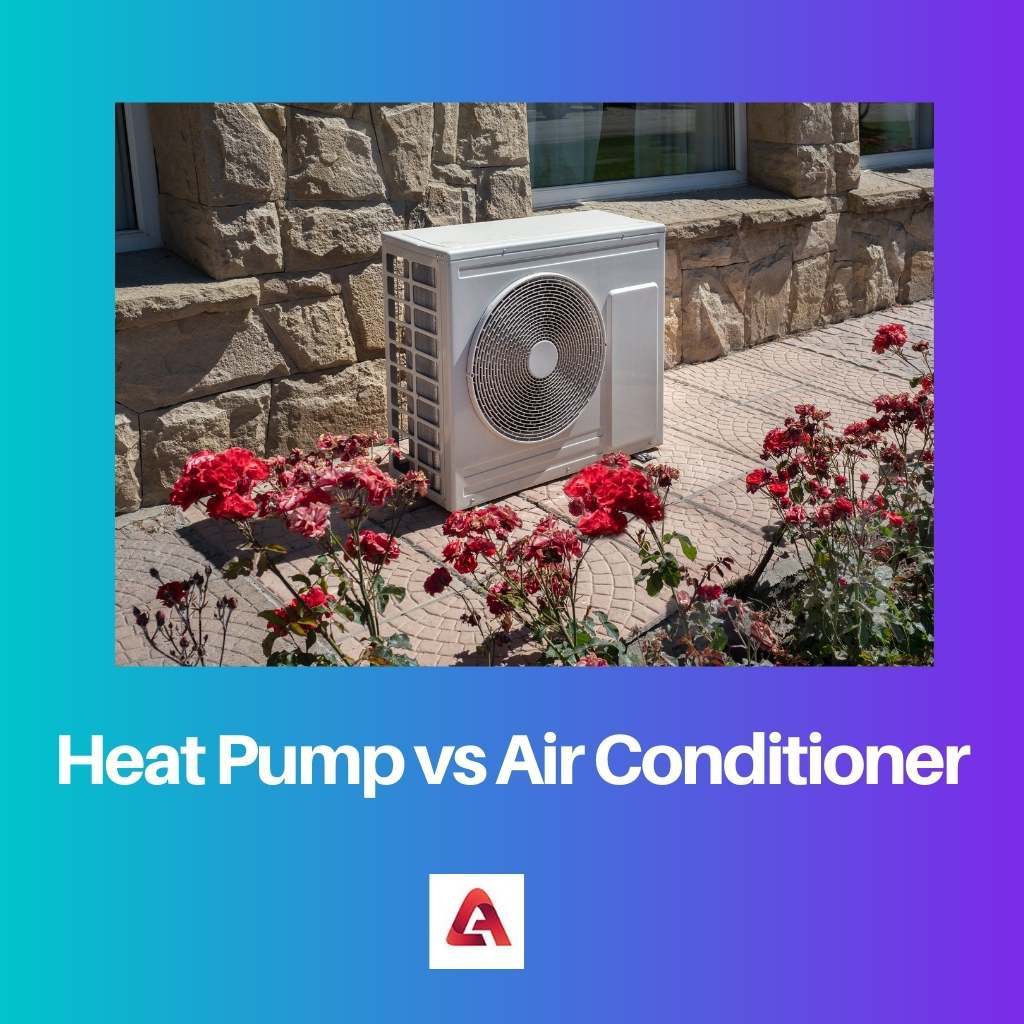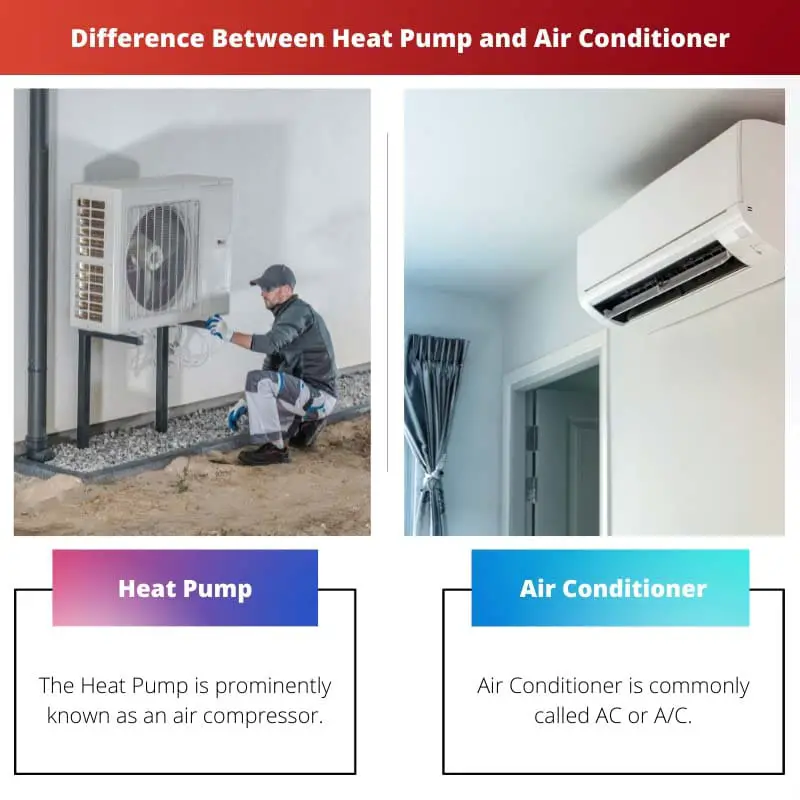The main purpose of Heat Pumps and Air conditioners is to maintain the temperature as per human body requirements. They are considered as replacements for HVAC equipment.
The 2 machines perform their functions using a refrigeration cycle. The Hybrid technology of Heat Pumps has certain unique features which differentiate it from Air Conditioners.
Key Takeaways
- Heat pumps can heat and cool a space, while air conditioners primarily cool a space.
- Heat pumps transfer heat from one area to another, making them more energy-efficient, whereas air conditioners remove heat from the air and release it outdoors.
- Air conditioners may suit extremely hot climates, while heat pumps work better in milder temperatures.
Heat Pump vs Air Conditioner
Heat pumps work in a similar way but can also reverse the process to provide heating and are more energy-efficient. Air conditioners work by removing heat from the indoor air and releasing it outside by circulating refrigerant between an outdoor compressor and an indoor evaporator coil.

The term Heat Pump refers to the electronic device that transfers hot air from one area to another area by making the temperature cool. It uses mechanical energy to transport heat from the cooler area.
It is mostly used in refrigerators and motor cars. It follows the refrigeration cycle to make the space cool or warm as against outside temperature.
The term Air Conditioner refers to a heavy electronic machine that eliminates heat from the atmosphere air by transferring it outside. It helps to control the room temperature as per user requirements.
It manages the humidity and makes the environment comfortable for the people using it. Air conditioners are available in packaged as well as split systems.
Comparison Table
| Parameters of Comparison | Heat Pump | Air Conditioner |
|---|---|---|
| Common Name | The Heat Pump is prominently known as an air compressor. | Air Conditioner is commonly called AC or A/C. |
| Basic Components. | It has 3 basic parts namely: Condenser, Compressor, and Evaporator. | It has 4 basic parts namely: Pump, Condenser, Expansion Valve, and Evaporator. |
| Primary Function | The primary function of the Heat Pump is to warm up the space. | The primary function of an Air conditioner is to make the area cool. |
| Use of Condenser | The Heat Pump use Condenser to produce hot air. | Air Conditioner uses a condenser to remove the heat from the cool air. |
| Coefficient | The Coefficient of performance is always more than one i.e. >1. | The Coefficient of performance is one or less than one i.e. 1 or <1 depending upon the temperature. |
What is Heat Pump?
The term Heat Pump refers to a machine used for transporting heat to thermal energy and vice versa for cooling and heating the temperature as per human body requirement.
The Heat Pumps operate on a reverse vapor compression cycle. When the climate is freezing or cool, the Heat Pumps help to control the temperature in a warm state. They are installed outside the premises.
In a Heat Pump, the condenser can be converted into an evaporator, and the evaporator can perform the function of a condenser.
The refrigerants used in the heat pump to convert energy are CFC (chlorofluorocarbons) and carbon dioxide. The mode of operation of a Heat Pump is completely depending upon the output desire of humans.
They heat the premises without choking.
The latest technology of Heat pumps contains air purifiers to make sure the surroundings are pollution-free inside. They are compact and convenient to utilize.
Some Heat Pump models are environment friendly since they do not burn fossil fuels. They are more efficient in heating than furnaces as they convert mechanical energy into thermal energy.
The most prominent category of Heat Pumps is Air -sourced and Ground Sourced.

What is Air Conditioner?
The term Air Conditioner refers to electronic equipment that provides cold air. It comes in a variety of shapes and sizes but operates on a single phenomenon. It creates cooling by eliminating humidity and heat from the room temperature.
Standard Air Conditioner devices use refrigerant chemicals to perform their cooling function.
It mainly has three components: a compressor, a condenser coil, and an evaporator coil, and they operate together to transfer the refrigerant from gas to liquid and reverse.
Air Conditioners also come in split systems that are fan-blowing air and releasing hot air outside are separated, which is very common in use. Split systems of Air conditioners are also referred to as Central Air.
The functions performed by AC also include controlling humidity and improvement of air quality. In the split Air Conditioner outdoor unit is called the condenser, and the indoor unit is called the evaporator.
The process of cooling through the Air conditioner is as follows: Initially, the cold liquid substance “Refrigerant” absorbs the heat from the area in the evaporator unit and cools the space.
In the next step, the refrigerant passes the heat to the compressor to convert the same into gas. That gastric refrigerant blows outside the AC with the help of a condenser coil. The whole process repeats to remove heating.

Main Differences Between Heat Pump and Air Conditioner
- Cycle: The heat Pump follows the reverse refrigeration cycle on the contrary, the Air conditioners follow the vapor compression cycle.
- Ideal Usage: Heat Pump works better in places with moderate temperatures, whereas Air Conditioners are ideal for usage in hot places throughout the year.
- Efficiency: The Heat Pump’s energy consumption is quite high compared to the Airconditioner, which is more energy-efficient.
- Mode of Operation: The heat Pump can maintain both a warm or cool atmosphere as per climate conditions, and the Air Conditioner can maintain only a cooling atmosphere.
- Longevity: Heat Pumps’ life expectancy is less than Air Conditioners as they are in use during summer only.





